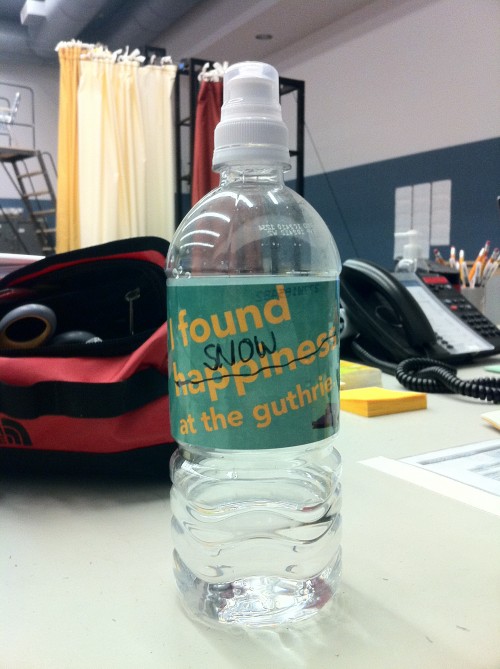A thought from yesterday:
Designer Run: so called because the designers are there, and everybody else is running around trying to finish blocking the show so the designers don’t think we’re idiots.
A thought from yesterday:
Designer Run: so called because the designers are there, and everybody else is running around trying to finish blocking the show so the designers don’t think we’re idiots.
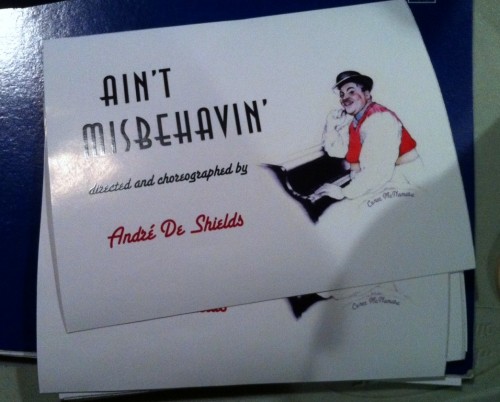
One of my side projects this week has been making the above happen.
Andr√© has wanted a nice-looking notecard on which to send personal invitations to the show. I’ve been working on the layout with him, and today we had them printed (at Staples, who lost the cap to my thumb drive, much to my dismay). They’re not actually postcards — we printed four of the same image on a 8.5″ x 11″ piece of glossy paper, and had them cut into quarters. They came out looking much better than I expected.
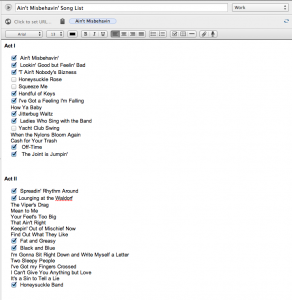 Just a quick use case for Evernote in rehearsal.
Just a quick use case for Evernote in rehearsal.
Right now we’re still focusing on music, so one of the few things to track in rehearsal is what songs we’ve covered. That’s the biggest challenge on this show — there are 31 of them.
When I’m PSM, I have a ridiculous database that tracks things like this, but this is a pretty simply-structured show, being basically a revue, with minimal blocking, sets and props, and most of what the database does is either not needed, or not needed when I’m the ASM.
Back when I was doing pre-production I made myself an Evernote note with the names of all the songs, because I wasn’t familiar with the show and knew I’d need to be referring to it often. If I were really on top of things I’d have the names of the characters who sing them on there. Maybe that’s my next project.
I didn’t really plan this, but I had nothing to do in rehearsal, and when I have free time when assisting, I do one of two things: create more paperwork than I probably need, and monitor things that the PSM is already doing, just in case it becomes helpful to have that redundancy — for instance if the PSM needs to be out of the room for an extended period he will miss some of what we were working on, and my paperwork can be used to double-check his list for the report.
So I started using my note to not just list the songs, but to check them off as we learn them. I love checkboxes in Evernote. On the Mac you can make them quickly with shift-command-T. I have a suspicion it’s shift-ctl-T on Windows. The system I came up with is that when we start a song, it gets a checkbox. When the song is completely taught it gets a checkmark.
Nothing fancy, but sometimes Evernote is so open-ended that I don’t quite know what to do with it. So here’s an example.
I only wish the iOS client didn’t crash so much. I would keep my run sheet on it. But I can’t have a run sheet that crashes just before a scene change, or loses its most recent changes, and I feel like that would happen at least five times a day, which is five times more per run than I can accept. Currently I’m writing the run sheet in Word. I’m not sure yet what method I’ll use during tech. It will very likely be paper.
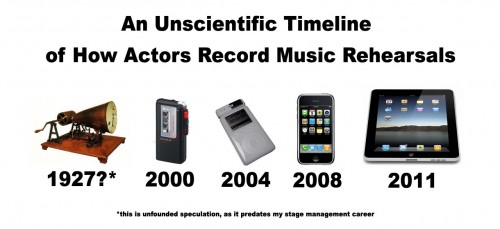
Today we started rehearsal for Ain’t Misbehavin’. After a very complex and inspiring opening speech from Andr√© De Shields, we spent the rest of the day on music.
While watching the actors rehearse, I noticed something I had not seen before: one of our actors was using her iPad to record her music. There’s really nothing surprising about this, but I made a mental note that it’s another small step in the evolution of technology in the rehearsal process. In addition to its capability for recording, she also uses one of the many piano simulators available for iOS to find her notes when reviewing music.
Most singers in musical theatre bring some kind of recording device with them to music rehearsals. They use it to capture their individual vocal parts as they’re being taught, the song as it is sung with everyone, and often they will use time on breaks or after rehearsal to have the musical director play through a whole song with the piano part only, creating essentially a karaoke track that they can then sing along with at will. The recordings allow them to continue to review the music at home, on the train, or anywhere else that they don’t have access to an accompanist. Naturally the recording device that allows this is an important tool.
When I started out, tape recorders — either full-size or mini cassettes — were what everybody used. Sometimes an actor would run out of tapes and would be lucky to be able to borrow a spare from a colleague. Batteries would die, and a stage manager who could immediately produce two AAs was a hero.
Around 2005 it seemed that many younger or more tech-savvy actors had switched over to purchasing a mic attachment for their iPods, allowing them to record huge amounts of music and sort through their recordings in an organized manner.
Naturally the plain ol’ iPod gave way to the iPhone and iPod Touch, which have built-in microphones and offer an even easier user interface for making and organizing recordings. The iPad is basically the same thing with a giant screen, so it’s no less useful. Maybe what struck me most about it was not so much what the iPad was doing for music rehearsals, but what its presence signifies in terms of how common the device has become since the iPad 2 came out. It definitely seems more mainstream, and no longer just an expensive experiment for early adopters and Apple enthusiasts. I actually feel like a little bit of a luddite for not having one, or thinking I need one.
I consider myself lucky that my stage management career has spanned a very interesting 10 years. I was around to see the end of a different way of doing things, but thankfully not for too long before the internet age took hold of most aspects of production. I imagine it’s something like what took place when computers began to operate lights, sound and automation in terms of the way the business has changed.
Today in rehearsal the actors were waiting to have their measurements taken, and engaging in a lively discussion about the ups and downs of the business. One of the women somehow got on the subject of the answering service, which made me laugh because it’s been so long since I’ve heard anybody bring up the idea of a service. The rest of the actors in the cast had never used one, having never worked professionally in the time before ubiquitous cell phones, email and texting. I added the stage managers’ perspective — how if, for instance, a call time changed, you had to call every actor at their home, their service, and their cell or pager number — because you never knew which phone they would be near, and cell phones were expensive and had short battery life, so were often turned off when not needed. And you certainly couldn’t rely on actors or production people to a) have an email address, or b) check it more than once a week. Nowadays you can send a single email or text to a mailing list and be confident everybody will get it in a timely manner, and with accurate information — imagine having to leave the same phone message 75 times in a row, and hoping you didn’t accidentally say the wrong time or day on one of them! And that is by far the best thing that’s happened to stage management in the last 10 years.
One last tip on the subject of recording vocal rehearsals: if by some chance your actor forgets to bring their recording device, whatever it may be, a handy way for the generous stage manager to help them out is to use your computer (or iPhone) to record their song and then email it to them immediately — a relatively painless way to keep their process moving, and have the song(s) waiting for them when they get home. The duration of said rehearsal would determine how time-intensive this favor is, but on the occasions that I’ve done it, the very grateful actor and musical director were economical and specific about when they were ready to record, which makes it pretty easy.
Tonight was our invited dress of The Comedy of Errors at the Guthrie. Over 300 students attending the Minnesota Thespian Society’s conference were in attendance. They also came to R&J‘s invited dress last year, and were probably our best audience of the entire tour, so those of us who experienced last year have been greatly looking forward to having such a warm group to be the first outsiders to see our Comedy and let us know if they thought it was funny.
We had five hours of rehearsal in the afternoon, a relatively tech-light day, as we fixed little staging things here and there. Last night we did an almost-run of the show (which could have been considered a relatively smooth run, but we ran out of time about five minutes before the end of the play) — but for all intents and purposes, we had already done a complete run before tonight.
I was nervous, but not really about calling the show. More about going from our 5:00 end of rehearsal to eating, re-typing sections of my calling script with things we changed that day (that were too convoluted to read without being re-typed), getting the stage prepared, our cast to their warmup, bringing my stuff up to the booth for the first time and making sure nothing is wrong up there while there’s still time to fix it, getting fight call done in the allotted 15 minutes (which never happens on the first couple tries), getting blackout check done, and opening the house in some manner of timeliness that doesn’t leave the Guthrie house staff thinking I’m incompetent. Then pacing around for a half hour (I only made it 15 minutes before I radioed Meaghan that I was going up to the booth), hoping none of our actors run into a costume or wig delay that requires holding the curtain, then going through the places procedures, coordinating Ian’s preshow curtain speech, remembering to leave time for Ian to get back to his seat before beginning the show, and finally starting the show. Everything after that point, I wasn’t really nervous about.
As I arrived in the balcony, I was anxious to just sit in the booth for 15 minutes putting the re-typed pages in my script and checking cue-by-cue that there were no errors, but before unlocking the door, I was compelled to pause for a moment to take a picture.

So the time came, I got the house right on time. Ian was with Meaghan backstage, waiting to hear word from me that we could begin. He came out and gave a brief speech welcoming the Thespians, telling them that he too had been a Thespian, and gave the usual director-at-invited-dress speech that basically goes, “this is a rehearsal, if something goes wrong you may hear my voice or someone else’s [i.e. mine] saying ‘hold’ and we’ll have to fix something.” I vaguely remember the kids either laughing or outright clapping at this.
Let me tell ye: all this week I’ve been hearing it from people. I have literally been stopped in the halls by Guthrie staff telling me how excited the Thespians are to come see the show. And I, in turn have said how excited we are to have them, since a comedy especially needs an audience to get its bearings. And I would be told, how the Thespians are so excited to be able to be the first to see it, and they don’t mind that it’s a rehearsal, and the thing they want more than anything in the world is to see the show stop!
Now, I was a young technical theatre person at that age (and a Thespian), and I felt the same way too — whenever I met someone who worked on Broadway, all I wanted to hear about were stories of things going wrong. So I didn’t take any offense to the fact that 300 kids desperately wanted to see me experience the ultimate disgrace a stage manager can suffer. So I would just laugh and say that I understood how they felt, but I hoped they would not get their wish!
So…
Ian gives his speech, and as foretold, the kids titter at even the possibility of seeing the show stop.
I remember to hold for Ian to come back. When I see the side house door swing open, I call:
“Electrics 2, Go” (which also takes the house to half)
I wait a little while longer for Ian to get up to the production row.
I’m about to call Electrics 3 (which is a fade to black) when I realize I hadn’t given a formal warning to our prop man Craig, who is also our flyman for the house curtain.
“I’m sorry, Craig, are you standing by?”
Nothing.
“Craig? Craig? Meaghan? Hello?”
This is not the first, not the second, not the third, and probably not the fourth time in my career I’ve lost contact between the booth and everyone on wireless comm just before or just after a performance has started. So it was more of a “here we go again” than anything else.
By this point people on the electrics and sound channels are chiming in that they can hear me, and our sound engineer, Brandon, is starting to talk me through troubleshooting my console (which is not the same one from the tech table, so I haven’t used it since last year, and haven’t had a chance to familiarize myself with any of the buttons beyond the three channels — and the conveniently labeled “God Mic” button, which I only knew about because when Ian mentioned it in his speech, Brandon was like, “hey have you found your God mic button yet?”).
So Brandon and I are making sure that I’ve got all my listen buttons and talk buttons lit, but I had successfully been communicating with Meaghan up until just before Ian’s speech, so it seemed unlikely that something was set wrong. Then Susan, our wardrobe supervisor, calls in from her office that she can hear me. This is also interesting, as she’s on the same channel as the deck crew, but not wireless. So it looks like we’ve lost the wireless. The whole time this trouble-shooting process is going on, I’m glancing from time to time at the red-labled “God Mic” button, deciding when to use it. I know the kids want nothing more in the world, so I’m not dreading it, just deciding based on the information coming in when to formally admit defeat.
Some time after the delay had gotten obvious, Michael (lighting designer) had said, “maybe we should go back to Cue 1,” which sounded like a good idea. Ian, sitting near the tech tables, had by this time been informed of what the problem was, and it was he who invoked the God mic (which was probably nice because the kids had a pre-existing relationship with him by now). He said something like, “I told you we might have to stop!” and the kids went wild. I also felt I was now off the hook about providing them with their desired train wreck, and thankfully in a way that didn’t disrupt the show at all.
Ian explained that we were having a communication problem (which surprised me momentarily at how he would know that, until I realized he was sitting with four people who were on headset), and that we would begin soon.
I was getting frustrated, and had just picked up my radio to see if Meaghan had maybe turned hers on by now, when suddenly the voices of Meaghan and Craig popped on headset! A split-second later my phone received a text message from Meaghan, which I no longer needed to bother reading. We rejoiced for a moment, and they told me they could hear me the whole time. We conferred that none of us had touched anything at the time the comm suddenly started working again, so we were at a loss to explain why it had broken or what could be done to prevent it again. It was a mystery, without any hint of an immediate explanation, so all of us, across all channels, agreed that the only course of action was to press forward and cross our fingers. There aren’t very many cues that pass between me and the deck crew (“unless there’s a problem!” we said uneasily), but Meaghan and I agreed to keep our radios on for an emergency.
Ian had something else he had wanted to say to the students, so he requested to be the one to speak when we were ready. Once we all agreed to employ the solution of “hope that doesn’t happen again,” I passed word to Ian, and he made his announcement, and off we went!
From that point things went very smoothly. This show, especially being a comedy, moves fast, and has lots of intricate parts that go from hysterical to “meh” pretty quickly if they’re not timed perfectly, so while we knew we could go through the motions safely and more-or-less correctly, we had only run once, and this was going to be a big test for us to not just do our jobs correctly, but to do them like a well-oiled machine. I think we all exceeded our own expectations. Things came together really well, and the audience was with us the whole way.
The big excitement for me was the curtain call. We didn’t have one. We hadn’t even run the last moments of the play in two days. So word was passed around to the cast to get in a line behind the curtain and take a simple bow.
I had a bunch of cues scrawled on the last page of my script that I had never called. We had only ever teched up until the curtain fell. Thankfully the cues existed, but I have a thing where curtain calls make me nervous. I don’t know why, they don’t even really “count” in the same way as the rest of the show, normally. I just always get all up in my head about doing the sequence of events properly.
I’ve been calling Phantom for six years, and the curtain call still gives me butterflies every time. To be fair, it’s actually pretty crazy, involves catching the Phantom’s mask from one person, handing it off to someone else while listening for clears, checking for open traps and cueing a bunch of automation. Like, “really? I have to do all this other stuff, and in the middle of it I have to have this mask in my hand?” Actually the way I do it is more like
1) remember to stick hand out
2) close hand when mask is felt
3) open hand when someone tugs on mask
and then the rest of my energy is focused on what’s happening onstage (which you can barely see because scenery is being struck right next to you).
So anyway, curtain calls freak me out. And here’s one I’ve never actually tried. Who knows that any of these cues actually do what they allegedly do? So I spent a good chunk of the last scene reading and re-reading the sequence so I could smoothly move from one cue to the next, knowing what was coming. It went flawlessly, thankfully! I won’t say I called a perfect show, but it wasn’t bad, and my crew backed me up when I gave them short preps on a couple occasions.
Everybody was in a celebratory mood afterward. Our production meeting was short and sweet, like our show is, and was done by 9:40, which was amazing after a couple of post-midnight nights this week. Pretty much the entire Comedy team went to Sea Change, the in-Guthrie restaurant/bar and most convenient source of post-show beverages. The mood was incredibly festive. We remarked several times how everyone was toasting and congratulating as if it was opening night. In a way, I think it was. We proved to ourselves that we could do it, and I think that’s far more important than whether the audience paid for their tickets or whether we’re having a formal party afterwards. I’m looking forward to building our confidence even more in our remaining rehearsals, so we have a really solid show to play in Minneapolis, to be ready for whatever the road throws at us.
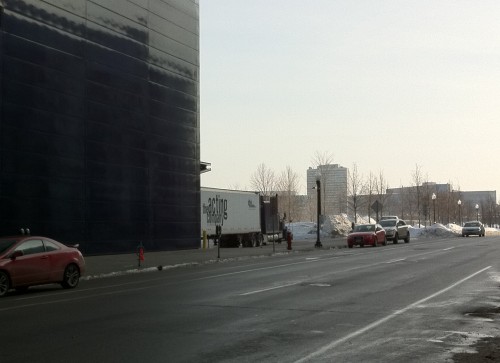
There’s always a part of my brain that knows when load-in is, but it’s not really connected to the walking-to-the-theatre-in-the-morning part, so it always comes as something of a surprise to me when I approach the Guthrie and see our truck at the loading dock. My first reaction is always, “what is that doing there?” Mostly because at this point my mind is still very much on finishing up our week in the rehearsal studio and also because I just associate the truck with performances and touring, and we’re still a long way from that. Mentally, at least!
Let me tell ye. I have been working for ten days straight. I am going to burn the metaphorical yule log for two days, and I hope I do not hear the following words for at least 48 hours:
1. groceries
2. shoes
3. handcuffs
4. bowler [hat]
That is pretty much my week-and-a-half summed up in four words. None of which has particularly much to do with the fact that today we completed our second full run of the show, and it’s falling-down funny (I keep waiting for something to make Ian actually fall on the floor — he’s come almost all the way out of the chair a couple times, but we’re not quite there yet).
But such is life that the things that take up most of my time are the little details that go on in the background, and if I’m lucky, most people on the production never know or need to worry about any of the convoluted process by which they’re made possible.
Yesterday, after I slapped a metal door frame a little too hard in response to #1, Meaghan was like, “can I help?” to which I responded, “there is nothing that can be done for this, it can only be solved by my death.” There is no way I know of to avoid these kind of situations short of not becoming a stage manager. Run away! Hit the back button on your browser while you still can! And if it’s too late to save yourself, well, take comfort in knowing that everyone is going through it.
 And with that, I wish all you dear readers a safe and happy holiday. And if you don’t celebrate Christmas, then even better — you probably got a couple days off for free just to chill. Which, after a video chat and remote present-opening with the fam in the morning, is what I intend to spend it doing!
And with that, I wish all you dear readers a safe and happy holiday. And if you don’t celebrate Christmas, then even better — you probably got a couple days off for free just to chill. Which, after a video chat and remote present-opening with the fam in the morning, is what I intend to spend it doing!
And no, I don’t have the same Christmas tree on my desk as I did last year. That’s a recycled picture, cause I never got around to taking a shot of the cute ornament my mom sent me. It’s made all of glass, with a palm tree and flamingo inside a glass ball with sand and a couple shells loose at the bottom. It’s so that we think warm thoughts in rehearsal. It seems to be working.
At the end of each rehearsal we have a little pow-wow lasting about a half hour to 45 minutes (if we’re lucky!) with the rather many people who are in the room, behind the tables each day.
There’s me and Meaghan, Ian our director, our two Jesse’s, both assistant-directorial types, who, in the style of our show, we have taken to referring to as Jesse of New York and Jesse of Los Angeles (and our two Elizabeths as Elizabeth of New York and Elizabeth of Minneapolis). Jesse of New York is our Staff Director, who maintains the show on the road, and Jesse of Los Angeles a former company member and budding director. Andrew Wade, our voice and text consultant, is also there, as well as Allie, the Guthrie’s Literary Intern, who assists our dramaturg and is in the room with us almost all the time.
At this meeting we talk about how the day went, and what we hope to accomplish the following day. We make the next day’s rehearsal schedule, including any costume and wig fittings that have been requested, and go down our respective lists of notes for the report and anything else we need to bring up with each other. Then I send the report, Meaghan and I publish and print our respective schedules (she handles the Guthrie format for the stage door), and we go home.
Tonight after this meeting, as Meaghan and I were walking out the door, Ian mentioned that there was one more thing he had been meaning to discuss with me, namely, “What has happened to your blog?”
Indeed, I haven’t been blogging nearly enough in proportion to the exciting things I should be talking about. Apparently when Ian recently spoke to a class of the Guthrie’s BFA students, it was mentioned by a student as a good source of information about the tour, lending further embarrassment to my lack of posting. The truth is I’ve been gathering material for an epic post about our rehearsal process, and then, well, we had a day off and I got lazy.
So without further ado, here’s what’s been going on, up to Day 9 of rehearsal (you can already read about Day 1.)
The big news is that by tomorrow, if all goes according to plan, we should have staged the play, maybe even run it. This play is a very different experience for me in my time with the company, because it’s short and has relatively few scenes (only 11). It’s estimated to be about 90 minutes with no intermission, so the rehearsal process has felt much more productive because we can focus in on things more at length without worrying about staging three hours’ worth of text. We only do about two scenes a day, which on paper looks slow, but without the pressure of having to cover 30 scenes, we’re able to spend much more time refining what we work on, taking chances, and changing our minds.
The biggest boost to our productivity is that we have most of our set in the rehearsal room. And now I have pictures.
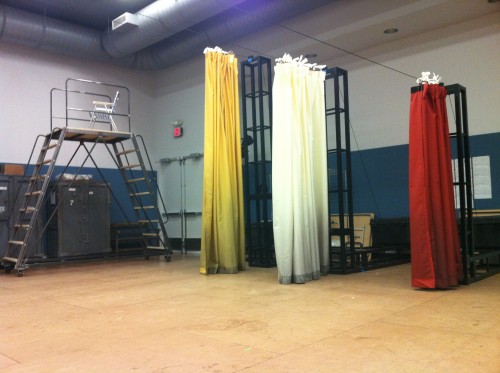
The basic element of the set is three sets of full-stage silk curtains which are suspended across the stage at varying heights between two towers. Black aircraft cable is strung between the towers and the curtains ride on them basically in the manner of a shower curtain. The engineering of this has been a huge ordeal for months — we can’t assume a theatre has a fly system, so the curtains must be supported from the ground, but then how do you counterweight a 30-foot-long expanse of cable with huge curtains hanging from it, without the towers being pulled over?
The answer: water. We thought we’d be carrying literally tons of counterweights on the truck, much to everyone’s dismay. What we ended up with is six large Pelican cases, which are watertight. When filled with water they weigh about 200 pounds each, and have wheels and handles for easy movement. The truss attached to the offstage side of the towers gets progressively longer the taller the tower is, allowing that 200lb box at the end to balance the load. I’m really glad it’s not my job to figure that kind of stuff out (I wanted to be a director, I thought my career would involve no math), but it works.
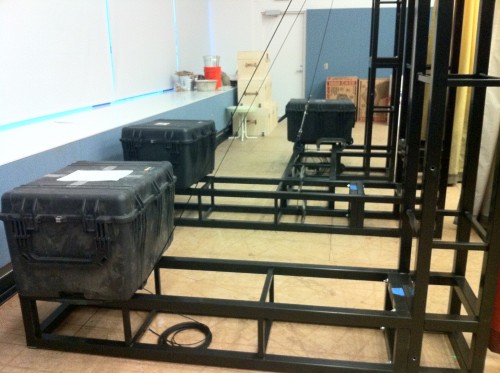
This view is offstage looking upstage-right. Because our rehearsal room is not as wide as the stage, the third tower is constructed a little differently. That piece joining the 2nd and 3rd towers is actually the extension of the 3rd tower’s leg that will run straight offstage when there’s more room. As you can see, there’s not a lot of offstage space here, but our cast has very quickly gotten adept at stepping between the bars and under the cables without jostling anything, which bodes very well for backstage life in tech and on the road.
Trying to stage this show without the curtains would have been nearly impossible, so I’m very grateful (as I’m sure the actors and the creative team are also) both to the money people and the technical people who have made it possible for us to have our actual set to play with for our entire rehearsal process. During the final week in the studio, once the scenic load-in begins, obviously the set has to go upstairs, but by then we’ll have had plenty of time to learn how it will be used and can mark it.
The other element we have in the room is the metal contraption shown upstage in the first photo, which in great understatement, is called simply “the ladder.” The platform is eight-and-a-half feet high (incidentally the exact same height as the balcony in R&J, which gives us a handy point of reference for how tall it will feel on stage), made of steel and wood, on locking castors. Much like our platform in R&J, named Fred, the unit has so much inertia and the castors are so solid, that it never needs to be braked, which is a great advantage, though it’s nice to have the option. The platform at the top is large enough for some furniture, and the inner triangle underneath provides an interesting space to duck in and out of. The height of the railings means it can only travel under the yellow curtain, but we haven’t felt the need to cut it down. It’s actually really cool how it can hide behind the yellow or white curtains for different effects. It was very imposing on the first day it arrived, but we have found it to be effective in many scenes, and the actors took to it right away and began experimenting with ways to use it. From a technical perspective, my experience has been that it’s a solid and well-built piece of work, constructed right here by the Guthrie’s prop shop.
So so far, all of our potentially problematic scenery is working great, and here we are on Day 9 using all of it. The only other scenic elements are an upstage wall with double doors at the center, and a painted deck with an apron extension, made to look like a tile floor. As far as props we also have three luggage trunks of varying sizes (built from scratch to be stood on, opened, and rolled by picking up from either end, so they’re very versatile), and a number of chairs, tables and hand props that appear in the room as we find the need to request them. We’ve been very well-supported on this show, and it’s been enormously helpful, since so much of the discovery of the staging and the comedy is born out of interacting with the set and the props. We even have a dimmable lighting instrument in the room to work on a particular scene that heavily relies on shadows made behind the curtains. Consider me a happy stage manager.
As far as everything else going on, we’re done with costume fittings until tech. We have a few wig fittings here and there, and are adding a beard for Ageon, which he just had a consultation for the other day. Nothing gives me stress more than trying to work fittings into a rehearsal schedule, so despite the fact that I wanted to kill myself in New York when trying to schedule fittings for two shows around a rehearsal schedule, I’m glad it’s been very low-key here.
The shoes went to be rubbered today. We don’t have a wardrobe person in Minneapolis, so this has become a stage management problem, which earned a name. Scenic people like to name particularly problematic pieces of scenery (R&J has Fred the platform, and Betsy (a wall), and then there’s Wall 3B, which we call by its proper name, but affixed a photo of fossilized dinosaur dung to, to make our feelings about it known). Anyway, much like this, when a project starts to become disproportionately difficult, I give it an official name. This one has been known as Project Rubber. I received word this morning: “Project: Rubber: Part One: The Reckoning (aka There but for the Grace of God) is complete.” So that’s off my plate.
We’ve rescheduled our weekly grocery runs around our somewhat brutal Christmas schedule. This is always an issue, because we rearrange the days off to give us both Christmas Eve and Christmas Day off, followed by New Year’s Day. That’s great, but it means we work ten days straight. Also our only days off for two weeks are national holidays, and no one wants to go grocery shopping (or drive us to the grocery store!) on those days, so we have to work the grocery runs into our rehearsal days. This year it’s infinitely easier because we’re doing 6-hour days, starting at 9:30 (to the chagrin of some), so we’re done for the day at 3:30 with time for groceries remaining. But it’s something I always have to work out with the Associate Company Manager, and I’m glad it’s out of the way and less of a pain for all involved than it usually is.
I just wanna talk about straight 6’s. For those not down with the lingo, a “straight 6” is a kind of rehearsal day allowed by a vote of a 3/4 majority of an Equity cast wherein you’re called for six hours, and instead of a real lunch break you make one of your breaks 20 minutes. And then you’re done. Unless you’re really far from food and/or have no fridge or microwave available, it’s a pretty awesome way to work. Usually the resistance comes more from directors, who do lose an hour or more of each rehearsal day by doing it that way, depending on the contract. But especially in a case like this where we’re rehearsing a comedy that requires the actors to be inventive and spontaneous, sometimes you get more work out of people in 6 good hours than in keeping them around the building for a 9 or 10-hour day.
A lot of it is just psychological. Here in the dead of winter where it’s dark before 5:00, it feels really good to be done for the day at 3:30. Not to mention that every day kind of feels like a day off in a way, because there’s still so many hours left to do shopping, watch TV or be productive in other ways. I have only very rarely gotten to do shows where the straight 6 was the status quo, and I’m totally in love. I was telling Meaghan the other day, I’ve done about 60 shows, and I think this is the 2nd or 3rd that has done so. It’s not appropriate in many cases (musicals especially), but when it is, it’s wonderful.
In fact, last year after the first preview of R&J at the Guthrie, I was having a drink with Ian when he first started trying to sell me on the 2010-2011 tour. All I remember about what he said was, “and when we’re doing Comedy at the Guthrie I want to do straight sixes.” I don’t think I heard anything after that, because I was penciling in “2010-2011 Acting Company Tour” from September 2010 to April 2011 in my mental calendar. Honestly, that was a huge mark in favor of doing the tour this year, and it has been everything I dreamed it would be. What should be the most stressful month of this job has been really nice — partially because things are truly running more smoothly than they ever have — but in large part because I don’t feel like I spend every useful hour of my day locked up in rehearsal.
I think it’s really important as a stage manager to stay attuned to your own sanity. I have learned that there are certain things that seem minor but greatly contribute to my sanity. The length of my commute is one. Length of the rehearsal day is another — they’re kind of related, they both ultimately determine how much free time I have. And I have learned in touring that the added expense of having my own hotel room is more than made up for in the reduction of stress it provides. These are just things to consider when weighing the pros and cons of a job, and not to be underestimated.
That’s what’s been going on this week. I think I’ve covered enough that I can show my face in rehearsal tomorrow morning. Next week we start fight rehearsals — this show isn’t as traditionally fight-heavy as R&J but our good friend Felix Ivanoff will be back to lend his insight to the various beatings and physical comedy throughout the play, which I’m sure will be lots of fun.
And as always happens, Christmas will distract us and then all of a sudden OMG we’re loading in, we’re doing designer run-throughs, and the next thing we know we’re on stage. But things seem to be on track and I’m excited to get to the next stage of the process. I can see a clear path ahead to bring this thing upstairs and show it to many thousands of people, and then for our truck and our rockstar buses to show up in the parking lot and take us to Brainerd and onward.
We found out Friday during rehearsal that there was a storm a-comin’. Some people thought it would be the storm of the decade. Some people were like, “it’s Minneapolis, they’re not afraid of snow.” We devised our rehearsal schedule for Saturday in such a way that if the people who weren’t staying within walking distance of the Guthrie got snowed in, we wouldn’t be totally screwed. Then we went to bed.
The storm began around midnight Saturday. Before I left the house at about 8:30AM, I looked out the window and could barely see the Guthrie. I live about two diagonal blocks away.
Here’s the view on Saturday morning (the camera is panned a little more to the right):
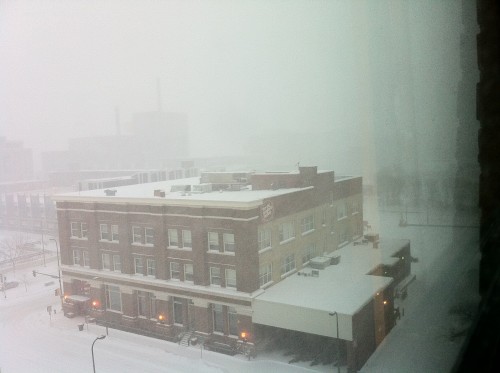
When I left the house there seemed to be about 6-8″ already on the ground. We began our rehearsal day, occasionally peeking out the window (we keep the blinds down usually) to see that our usual view of the Mississippi and the factories across the river was a view of total whiteness. You couldn’t see the river at all. One of the bridges was the faintest shadow. Then we decided this needed to be seen from the Endless Bridge (which I spoke about a bit at the end of my last post).
On our lunch, I walked out to the end of the bridge.
Here’s a picture of me in 2008, also during a snowstorm apparently.
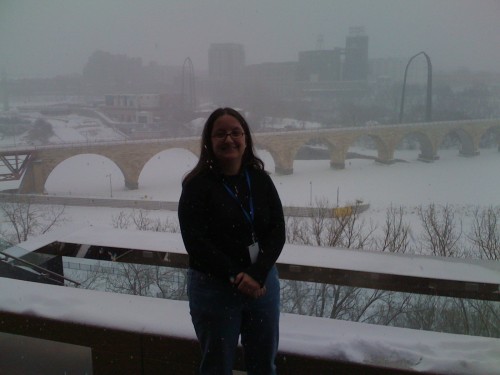
Note that you can see the snow-covered river, the bridge, and buildings on the other side.
Here’s the view on Saturday. I didn’t go outside because the snow was about a foot high in front of the door, so I had to take a picture out the blue window. The bench in the foreground is the one I’m standing against in the above picture. The whiteish spots are the reflections of the other windows on the bridge.
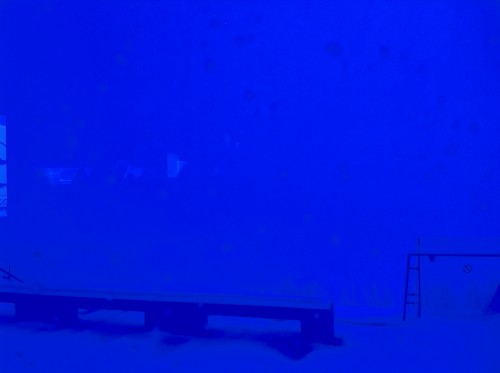
We finished rehearsal at 3:30, with the snow forecasted to continue until midnight. By the time we left rehearsal the snow was over a foot. I walked home through sidewalks completely covered in a foot of soft snow, that had had barely any covering them when I walked them in the morning. That was exhausting. Around the same time the city/county stopped bus service and recalled the plows from the roads. I think this is when people started to realize how screwed we were. I was just glad all our actors could get home.
This morning we woke up and had to make it back in for another 9:30 rehearsal, with the city covered in snow and temperatures now hovering around zero. Meaghan called me just as I was about to leave the house to report that her car was stuck in an unplowed driveway to the Guthrie’s parking garage. I joined her — thankfully she had a shovel in her car, and I cleared a neater path as she guided her car between the snowbanks.
One of our actors’ car was snowed in at home, but he couldn’t take public transportation as he did the day before, because bus service wasn’t resuming until 10AM. He eventually managed to get a cab, and was miraculously only about 15 minutes late.
After getting my morning workout shoveling the parking garage, we finally got to the rehearsal room, where our director told us about the Metrodome roof caving in overnight. I was staring right at it while shoveling snow, and didn’t notice. So before rehearsal I took a quick trip up to the 9th floor lobby, which provides a perfect view out its crazy yellow windows.
Here it is last year, just before the final Vikings playoff game:
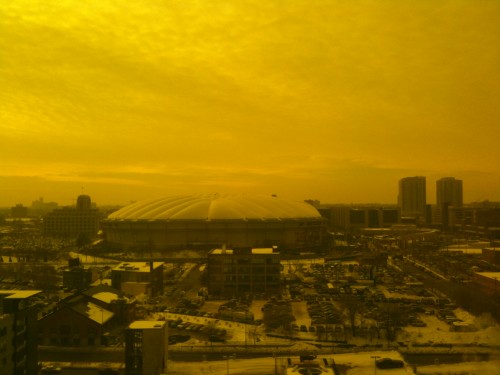
And today, as one of my actors described it, “Like a souffle that couldn’t.”

Also, there’s a crazy video of the inside as the roof came down:
All in all I believe it was recorded as 17″ of snow. The streets seem pretty clear, at least around here, but the sidewalks have taken all of the snow that was plowed off the street, and are still piled up several feet high on some blocks, especially at the corners. I will have to be more selective about which streets to walk down. Getting home today was a bit of a mountain-climbing adventure.
Towards the end of rehearsal today I got creative with my water bottle, which seemed to sum up what this weekend has been like:
